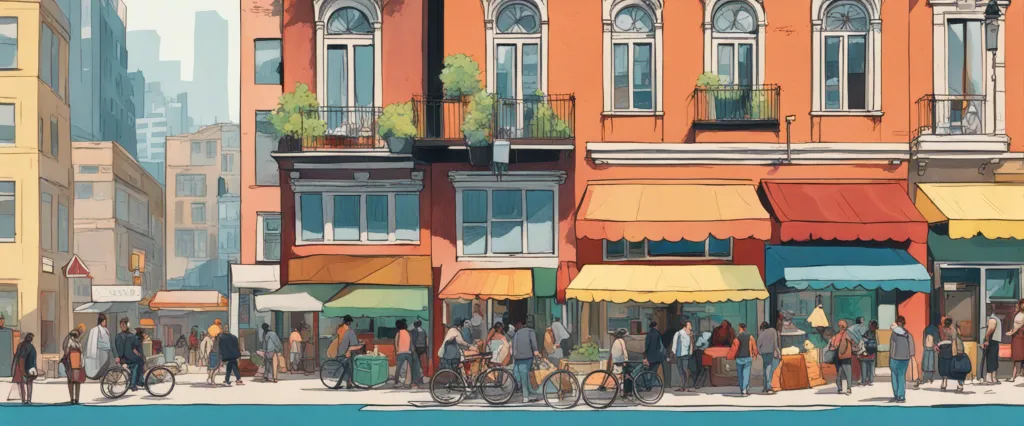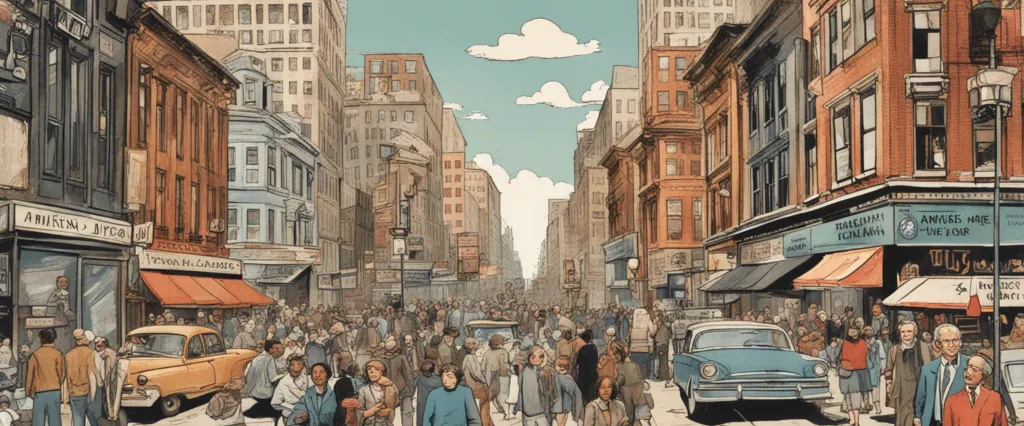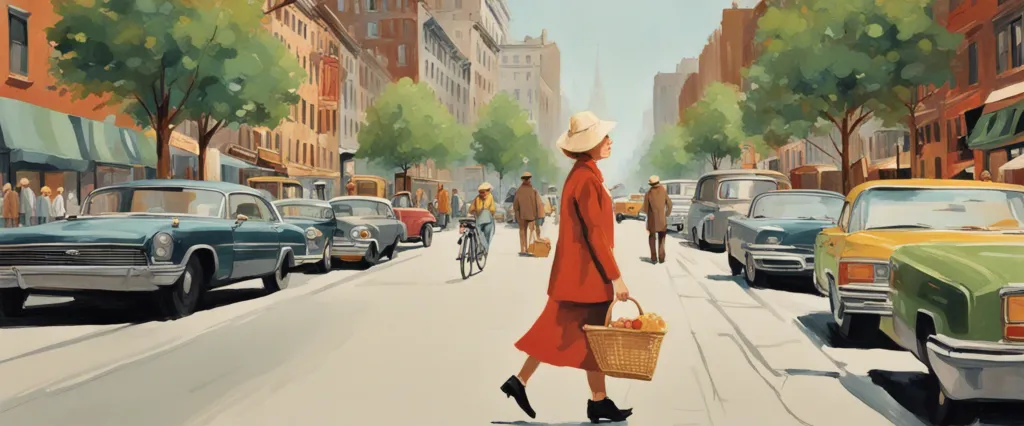
In her groundbreaking urban planning manifesto, “The Death and Life of Great American Cities,” Jane Jacobs challenges conventional wisdom and offers a fresh perspective on urban development. Published in 1961, Jacobs boldly questions the prevailing practices of city planning that dehumanize urban environments and detrimentally affect the lives of their inhabitants. A self-taught urbanist and journalist, Jane Jacobs was a remarkable woman who defied conventional notions of expertise, fearlessly challenging the powerful institutions shaping the cities of her time. Through her keen observations and passionate arguments, Jacobs implores us to reconsider our approach to urban planning, urging us to prioritize the needs and desires of the people who inhabit these cities over the agenda of external forces.
Chapter 1: The Conditions for City Diversity
In Chapter 1, titled “The Conditions for City Diversity,” Jane Jacobs introduces the fundamental elements that contribute to the vitality, diversity, and success of cities. She argues that urban liveliness stems from a combination of four main conditions:
1. Mixed primary uses: Jacobs emphasizes the importance of having a diversity of activities in close proximity within a city block or neighborhood. This means combining different functions such as residential, commercial, cultural, and recreational, allowing for a constant mix of people and activities throughout the day and night.
2. Short blocks: According to Jacobs, shorter blocks in cities provide more frequent intersections, which promote pedestrian movement and social interaction. These shorter blocks create a more intricate web of streets, enabling people to explore different areas easily, leading to a diverse and active public life.
3. Buildings of various ages and types: Jacobs argues that a mix of old and new buildings, of varying architectural styles and sizes, is crucial for a city’s visual interest and functional adaptability. Older buildings often provide more affordable options for diverse businesses, while newer developments can accommodate changing needs and preferences.
4. Density: Contrary to popular belief at the time of the book’s publication (1961), Jacobs argues that high population density is essential for a thriving city. More people mean more potential customers, social interactions, and economic opportunities, leading to a vibrant urban environment.
Jacobs suggests that these four conditions work together to create diversity, support local economies, and foster a sense of community within a city. In her view, cities become more attractive and vibrant when these elements are embraced and maintained.
Chapter 2: The Uses of Sidewalks: Safety
Chapter 2 of “The Death and Life of Great American Cities” by Jane Jacobs explores the importance of sidewalks and their role in fostering safety and community within urban neighborhoods. Jacobs argues that sidewalks play a crucial role in promoting safety due to the constant presence of people on the streets, creating what she calls “eyes on the street.”
According to Jacobs, an active and vibrant sidewalk encourages safety in three key ways. First, sidewalks promote a sense of ownership and territoriality among residents, making them more invested in the well-being of their neighborhood. When people frequently use sidewalks, they become familiar with their surroundings and are more likely to notice any suspicious or harmful activities taking place. This collective surveillance acts as a deterrent and ensures that potential wrongdoers are constantly being watched.
Second, an active sidewalk fosters social interaction and community engagement. Jacobs argues that when people frequently interact with one another on the streets, a network of relationships and connections develops, resulting in a stronger sense of community. This sense of community creates a supportive environment where residents look out for one another and are more likely to report any suspicious activities to the authorities.
Lastly, Jacobs emphasizes the importance of mixed-use development and diverse businesses along sidewalks. She asserts that when there is a variety of activities and establishments, such as shops, restaurants, and parks, people are drawn to the area, increasing its vitality and safety. The presence of these activities attracts different individuals throughout the day, ensuring a constant flow of people and reducing the risk of crime.
In conclusion, Jacobs argues that active and vibrant sidewalks, with a strong sense of ownership, community engagement, and diverse businesses, are essential for promoting safety within urban neighborhoods. By focusing on the importance of sidewalks, Jacobs calls for a reevaluation of urban planning strategies to prioritize pedestrian-friendly spaces, ultimately creating vibrant and secure communities.
Chapter 3: The Uses of Sidewalks: Contact
Chapter 3: The Uses of Sidewalks: Contact, from Jane Jacobs’ book “The Death and Life of Great American Cities,” discusses the importance of social interactions and the role sidewalks play in fostering vibrant communities.
Jacobs argues that sidewalks are essential for ensuring the safety and vibrancy of city streets. She emphasizes the value of “eyes on the street,” asserting that crowded and lively sidewalks generate a sense of safety as they provide a constant presence of observers. This presence discourages potential criminals, creating an informal system of surveillance that is more effective than formal security measures.
According to Jacobs, busy sidewalks also encourage diverse uses and interactions. She brings attention to the significant variation of sidewalk activities throughout the day, highlighting how different groups and individuals use public space at different times. From children playing in the morning to workers grabbing lunch, and later to a vibrant nightlife scene — sidewalks accommodate various needs and foster a sense of community.
Moreover, the author emphasizes the importance of “sidewalk ballet” — the intricate and spontaneous movement of people on the sidewalks. Jacobs argues that this ballet contributes to the social fabric of neighborhoods, as it allows for unplanned encounters and creates connections between strangers. She notes that these casual interactions significantly benefit residents’ well-being and sense of belonging.
Overall, this chapter underscores the idea that sidewalks are not just transportation conduits; they are essential social spaces that foster a sense of community, ensure safety, and provide opportunities for diverse interactions. Jacobs highlights the vital role of sidewalks in creating vibrant, successful neighborhoods and emphasizes the need to design cities with prioritized pedestrian infrastructure.
Chapter 4: The Uses of Sidewalks: Assimilating Children

Chapter 4 of “The Death and Life of Great American Cities” by Jane Jacobs, titled “The Uses of Sidewalks: Assimilating Children,” explores the crucial role that sidewalks play in the social fabric of cities, specifically in regards to the development and assimilation of children.
Jacobs argues that children naturally play an essential role in the life of a city, as they have no choice but to be involved in the social dynamics of the neighborhood. Sidewalks act as a space where children can engage in unstructured play, interact with their peers, and learn valuable social skills. They provide a platform for children from diverse backgrounds to mingle and create relationships, fostering a sense of belonging and community.
Furthermore, Jacobs emphasizes the importance of adults actively participating in the life of the sidewalk. Parents and guardians who allow their children to play outside on the sidewalks tend to form connections and relationships with other adults, creating a vibrant and supportive network. These connections go beyond simple pleasantries and often lead to mutual care and assistance.
Jacobs criticizes the notion that designated parks and playgrounds are sufficient for child development, arguing that they isolate children from the dynamic life of the street. She proposes that everyday sidewalks, filled with different activities and interactions, offer a more comprehensive and meaningful experience for children.
In essence, Jacobs suggests that an active and diverse sidewalk culture, woven into the fabric of the city, is vital for the positive development and assimilation of children. Sidewalks become a vital space where children can learn and grow, fostering a strong sense of community and connection between residents of all ages.
Chapter 5: The Uses of City Neighborhoods
Chapter 5 of “The Death and Life of Great American Cities” by Jane Jacobs, titled “The Uses of City Neighborhoods,” explores the multitude of functions that neighborhoods play in the vitality of a city. Jacobs emphasizes the importance of diverse and mixed-use neighborhoods in order to create a vibrant urban environment.
According to Jacobs, neighborhoods are the building blocks of a successful city. She argues that a mix of different uses, such as residential, commercial, and recreational, within close proximity is essential for a neighborhood’s dynamism. Mixed-use neighborhoods encourage a steady flow of people throughout the day, which leads to more eyes on the street and increased safety.
Jacobs also discusses the concept of neighborhood self-policing, asserting that a diverse mixture of people from different walks of life strengthens social bonds within a community. She highlights the importance of a “sidewalk ballet,” where residents regularly engage in local street activities, from small talk to monitoring the neighborhood, contributing to a sense of security and togetherness.
Furthermore, Jacobs argues against the conventional practice of segregating land uses, which she believes results in dull, lifeless areas. She criticizes the influence of zoning regulations that prioritize the separation of uses, ultimately diminishing the vitality of city neighborhoods.
Overall, Jacobs emphasizes that neighborhoods are alive and constantly evolving entities that serve various purposes beyond mere residential space. By embracing diverse uses and encouraging community interaction, neighborhoods can foster an engaging and inclusive urban environment that promotes safety, connectivity, and liveliness.
Chapter 6: The Generators of Diversity
Chapter 6 of “The Death and Life of Great American Cities” by Jane Jacobs, titled “The Generators of Diversity,” explores the crucial elements that contribute to the vitality and diversity of urban neighborhoods.
Jacobs argues that there are four main factors that generate diversity within a city. The first is the presence of mixed primary uses within a district. She explains that a combination of residential, commercial, and cultural activities fosters a continuous flow of people throughout the day, creating a lively and vibrant atmosphere. This mixture of uses also promotes safety by ensuring that there are eyes on the street at all times.
The second factor is self-generated diversity. Jacobs emphasizes the importance of buildings and developments of different ages, sizes, and levels of upkeep, as they attract individuals with varying income levels and lifestyles. This variety, she argues, leads to a more diverse community, both in terms of demographics and the types of businesses that can thrive in the area.
The third factor is small blocks, which enable a higher concentration of different activities, ensuring that people have various places to visit within a short walking distance. Small blocks also encourage pedestrian movement and help prevent monotony in the urban fabric.
Lastly, Jacobs highlights the importance of multiple-plot ownerships. She argues that having a large number of property owners within a neighborhood fosters competition, diversity, and a sense of ownership and pride. It also prevents the concentration of power and allows for a more democratic distribution of influence.
In this chapter, Jacobs emphasizes the vital role that these diverse generators play in creating thriving urban neighborhoods. By having mixed primary uses, maintaining diverse buildings, creating small blocks, and encouraging multiple-plot ownerships, cities can promote vibrant and safe communities where people from different backgrounds can interact, resulting in a more fulfilling and harmonious urban experience.
Chapter 7: The Need for Mixed Primary Uses
Chapter 7 of “The Death and Life of Great American Cities” by Jane Jacobs focuses on the importance of mixed primary uses for the vitality and success of urban neighborhoods.
Jacobs argues that cities need a variety of diverse uses in order to thrive. She criticizes the prevailing urban planning ideologies of the time, which favored large-scale, single-use projects. The prevalent belief was that separating uses, such as having separate residential, commercial, and industrial zones, would create more efficient and orderly cities. However, Jacobs challenges this notion and suggests that a diverse mix of uses is crucial for attracting people and fostering vibrant communities.
According to Jacobs, mixing primary uses within neighborhoods is essential because it leads to increased activity and promotes a sense of safety. She asserts that neighborhoods benefit from having a combination of residential, commercial, and recreational activities in close proximity to each other. This mixture brings different groups of people together and creates a lively street life, which ultimately enhances the social and economic fabric of a neighborhood.
Furthermore, Jacobs emphasizes the importance of short blocks and small-scale buildings in creating a lively urban environment. She believes that long blocks and large buildings disperse activity and diminish street life. By contrast, compact and diverse neighborhoods encourage more walking, which increases safety, social interaction, and economic vitality.
In summary, Chapter 7 underscores the significance of mixing primary uses within neighborhoods to create vibrant, safe, and prosperous urban spaces. Jacobs challenges the dominant urban planning philosophies that favor separation and advocates for the integration of various activities as a means to foster thriving communities in cities.

Chapter 8: The Underlying Forces of Decline and Renewal
In Chapter 8: The Underlying Forces of Decline and Renewal of “The Death and Life of Great American Cities” by Jane Jacobs, she explores the factors that lead to the decline or renewal of cities. Jacobs argues that understanding the dynamics behind these forces is essential in order to preserve and enhance vibrant urban communities.
Firstly, she emphasizes the importance of diversity within a city. Jacobs believes that diverse economic activities and a mixture of old and new buildings create a city’s “economic ecosystem.” When an area becomes overly specialized or stagnant, it can lead to economic decline. Conversely, a mix of businesses and a constantly changing urban landscape can foster growth and renewal.
Jacobs also discusses the role of import-replacement and export-oriented activities in a city’s economy. She argues that import-replacement economies, where goods and services are produced and consumed locally, are essential for creating stability and a strong sense of community. On the other hand, cities that depend heavily on an export-driven economy may experience periods of boom and bust, as they are susceptible to fluctuations in external demand.
Another key aspect highlighted by Jacobs is the importance of a city’s public spaces. She believes that well-designed, diverse, and accessible public spaces are vital for fostering social interaction, which ultimately strengthens neighborhoods and instills a sense of belonging. Neglecting or mismanaging public spaces can lead to a decline in community engagement and overall urban decay.
Overall, Jacobs argues that cities flourish when they embrace diversity, create a balance between import-replacement and export-oriented activities, and prioritize the quality of their public spaces. By understanding these underlying forces of decline and renewal, urban planners and policymakers can work towards creating and preserving vibrant, sustainable, and livable cities.
After Reading
In conclusion, Jane Jacobs’ groundbreaking book, The Death and Life of Great American Cities, challenges conventional urban planning principles and offers a fresh perspective on the vitality and resilience of diverse and vibrant city neighborhoods. Jacobs argues against large-scale urban renewal projects that often lead to the destruction of close-knit communities and instead emphasizes the importance of mixed-use neighborhoods, organic street networks, and active public spaces for creating thriving urban environments. By emphasizing the need for human-scale development and local involvement in shaping communities, Jacobs invites readers to rethink traditional approaches to urban planning and advocates for a more organic and community-centric approach to shaping our cities. Overall, The Death and Life of Great American Cities remains a timeless and influential work that continues to inspire and inform urban planners, policymakers, and citizens alike.
1) “Thinking, Fast and Slow” by Daniel Kahneman – This book explores the two systems of thought that drive our decisions and behaviors, shedding light on the quirks and biases of human psychology. Like “The Death and Life of Great American Cities,” it challenges conventional wisdom and offers valuable insights into how our surroundings shape our actions.
2) “Guns, Germs, and Steel: The Fates of Human Societies” by Jared Diamond – In this Pulitzer Prize-winning book, Diamond investigates the broad patterns of human history and the factors that have contributed to the rise of certain civilizations. Similar to “Sweetness and Power,” it delves into the impact of resources, technology, and geography on the development of societies worldwide.
3) “Sapiens: A Brief History of Humankind” by Yuval Noah Harari – Offering a captivating overview of human history, Harari’s book presents a thought-provoking narrative about our species’ journey from hunters and gatherers to the dawn of civilization. Just as “The Better Angels of Our Nature” explores the decline of violence, “Sapiens” examines the monumental shifts that have shaped the course of human evolution.
4) “The Omnivore’s Dilemma: A Natural History of Four Meals” by Michael Pollan – With a focus on the modern food industry, this exploration of our eating habits and the impact of our food choices uncovers the complex relationships between nature, culture, and nutrition. It resonates with “At Home” by emphasizing the interplay between our surroundings, sustainability, and our daily lives.
5) “Evicted: Poverty and Profit in the American City” by Matthew Desmond – Drawing on extensive research and personal stories, Desmond exposes the devastating consequences of the affordable housing crisis in America. This book complements the discussions in “The Death and Life of Great American Cities” by shining a light on the social and economic forces that shape urban spaces and the lives of those who inhabit them.


